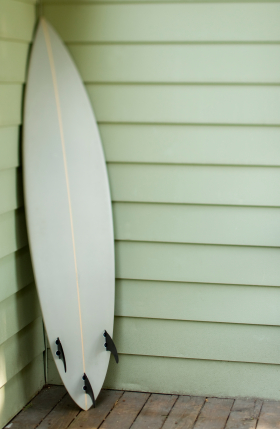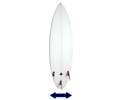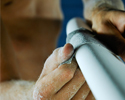Materials
Resin-ate and Be Great
 Polyester Resin/Fiberglass – These two materials are traditionally used with polyurethane (PU) foam blanks. The standard shortboard PU core is covered with one layer of 4oz “E” cloth on the bottom and two layers on top. “S” cloth can also be used and will strengthen a board with no increase in weight. The fiberglass cloth is then coated with clear polyester resin.
Polyester Resin/Fiberglass – These two materials are traditionally used with polyurethane (PU) foam blanks. The standard shortboard PU core is covered with one layer of 4oz “E” cloth on the bottom and two layers on top. “S” cloth can also be used and will strengthen a board with no increase in weight. The fiberglass cloth is then coated with clear polyester resin.
Pros: Although more shapers are producing boards with alternative materials, it is much easier to order a custom Polyester/PU board. Professional surfers prefer this combination for their performance and flexibility. Polyester resin is cost effective and a time-tested material.
Cons: Polyester is much more susceptible to fractures and dings. Fiberglass resin and PU are not environmentally friendly materials. For these reasons the leaders of the shaping community are finding ways to combat the “disposable board” syndrome.
Myths: A PU blank is not limited to polyester resin. Epoxy works, too.
Epoxy Resin/Fiberglass – Since Clark foam shut down operations, extruded polystyrene (XPS) and expanded polystyrene (EPS) blanks have gained popularity. These materials will dissolve if polyester resin is used. Glassers must employ epoxy resin. You won’t find many shapers making custom EPS or XPS boards, but it is very easy to purchase brand name models off the rack. Although epoxy resin can be used with PU, it more commonly found with EPS foam. The Epoxy/EPS combo has some advantages over traditional Polyester/PU boards.
Pros: This material is lighter, stronger and more buoyant. As a rule epoxy resin is twice as fracture resistant as polyester resin. Many riders claim these boards paddle extremely well and enable them to drop a few inches from their board length. Epoxy is also much less toxic than polyester resin. According to SurferSteve.com, some epoxy boards in the surf shops may only use epoxy resin in the laminate. Ask questions. One last benefit: If shaping with epoxy resin you will like the fact that it hardens much more gradually than polyester resin.
Cons: Epoxy resin is twice as expensive as polyester resin. Non PU boards also require more labor, resulting in a more expensive board. If using EPS then the board will absorb water more so than either PU or XPS if you experience a fracture.
Myth: To the contrary of just about anything you read, hand shaped Epoxy/EPS boards are more flexible than your current polyurethane board. The fact that epoxy is stronger than polyester makes it difficult to see that epoxy is also more elastic.














0 Comments